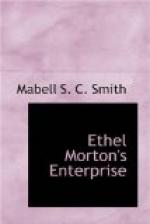[Illustration: “It looked just as if it were a house with a lot of rooms”]
“When I grow up,” said Ethel Blue, “I’m going to have a large microscope like the one they have in the biology class in the high school. Helen took me to the class with her one day and the teacher let me look through it. It was perfectly wonderful. There was a slice of the stem of a small plant there and it looked just as if it were a house with a lot of rooms. Each room was a cell, Helen said.”
“A very suitable name,” commented Ethel Brown.
“What are you people talking about?” asked Helen, who came in at that instant.
“I was telling the girls about that time when I looked through the high school microscope,” answered Ethel Blue.
[Illustration: Single Cell]
[Illustration: Double Cell]
“You saw among other things, some cells in the very lowest form of life. A single cell is all there is to the lowest animal or vegetable.”
[Illustration: Multiple Cells]
“What do you mean by a single cell?”
“Just a tiny mass of jelly-like stuff that is called protoplasm. The cells grow larger and divide until there are a lot of them. That’s the way plants and animals grow.”
“If each is as small as those I saw under the microscope there must be billions in me!” and Ethel Blue stretched her arms to their widest extent and threw her head upwards as far as her neck would allow.
“I guess there are, young woman,” and Helen went off to hang her snowy coat where it would dry before she put it in the closet.
“There’th a thnow flake that lookth like a plant!” cried Dicky who had slipped open the window wide enough to capture an especially large feather.
“It really does!” exclaimed Ethel Blue, who was nearest to her little cousin and caught a glimpse of the picture through the glass before the snow melted.
“Did it have ’root, stem and leaves’?” asked Dorothy. “That’s what I always was taught made a plant—root, stem and leaves. Would Helen call a cell that you couldn’t see a plant?”
“Yes,” came a faint answer from the hall. “If it’s living and isn’t an animal it’s a vegetable—though way down in the lower forms it’s next to impossible to tell one from the other. There isn’t any rule that doesn’t have an exception.”
“I should think the biggest difference would be that animals eat plants and plants eat—what do plants eat?” ended Dorothy lamely.
“That is the biggest difference,” assented Helen. “Plants are fed by water and mineral substances that come from the soil directly, while animals get the mineral stuff by way of the plants.”
“Father told us once about some plants that caught insects. They eat animals.”
“And there are animals that eat both vegetables and animals, you and I, for instance. So you can’t draw any sharp lines.”
“When a plant gets out of the cell stage and has a ’root, stem and leaves’ then you know it’s a plant if you don’t before,” insisted Dorothy, determined to make her knowledge useful.




